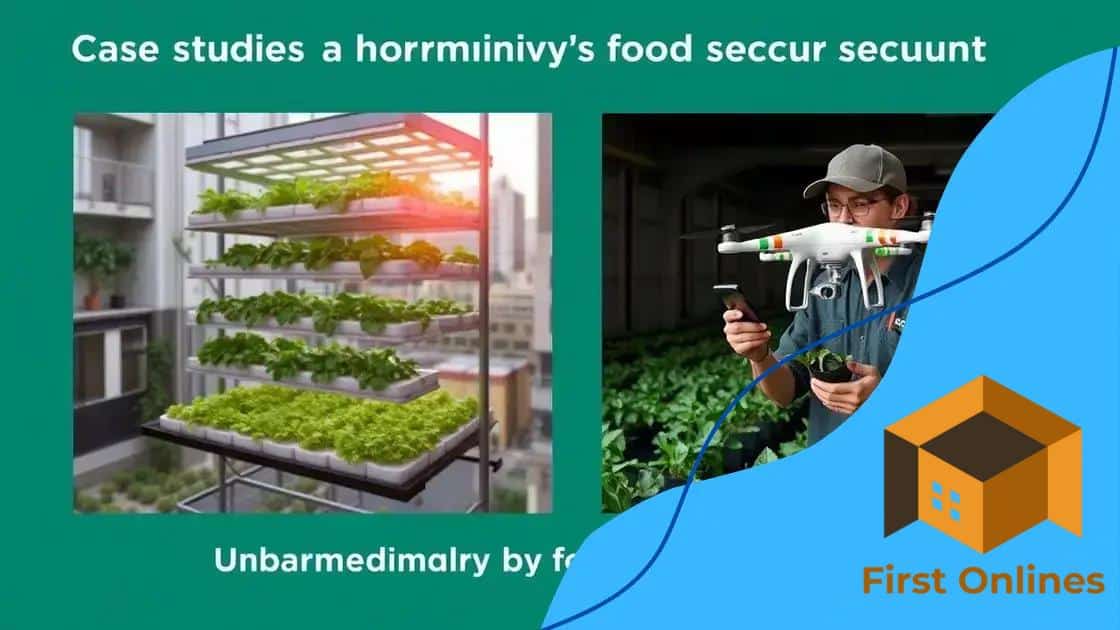The role of technology in addressing global food security issues

Anúncios
The role of technology in addressing global food security issues includes enhancing agricultural efficiency, utilizing data analytics for informed decision-making, and adopting sustainable practices to ensure reliable food production.
The role of technology in addressing global food security issues is more significant than ever. With the world’s population growing, how can we use innovation to ensure everyone has enough to eat? Let’s explore some potential solutions.
Anúncios
Understanding global food security challenges
Understanding global food security challenges is essential in today’s world. Food security means having access to enough nutritious food for a healthy life. With the global population expected to reach 9 billion by 2050, the pressure on food systems is mounting.
Key Challenges to Food Security
Various factors affect food security worldwide. Some of the major challenges include:
- Climate change: Rising temperatures and extreme weather events disrupt agricultural production.
- Economic instability: Fluctuating prices can make food unaffordable for many.
- Population growth: More people mean higher demand for food, straining existing resources.
- Resource depletion: Overuse of land and water leads to reduced agricultural productivity.
These challenges create a complex web of issues that need innovative solutions. For instance, improving agricultural practices can help communities adapt to changing climates and increase yields. Additionally, better distribution systems can ensure that food reaches those who need it most.
Anúncios
The Role of Policy and Governance
Effective policies and governance play a critical role in addressing food security. Governments must work together with local communities to create sustainable solutions. Policies that support local farmers and promote fair trade can significantly impact food availability.
Moreover, international cooperation is vital. By sharing knowledge and resources, countries can create a unified front against food insecurity. It’s not just about producing more food; it’s about making it accessible and sustainable.
As we delve deeper into understanding these challenges, we can begin to see the pathways to solutions. Technology and collaboration are key to overcoming obstacles.
Innovative technologies in agriculture

Innovative technologies in agriculture have transformed how we grow food. These advancements help farmers increase productivity while using resources more efficiently. New solutions are essential to ensure food security in a rapidly changing world.
Precision Agriculture
One major advancement is precision agriculture. This technology involves using data and analytics to optimize farming practices. Farmers can monitor their crops with drones and sensors, enabling them to make informed decisions.
- Soil health: Sensors help assess soil moisture and nutrient levels.
- Crop monitoring: Drones capture images and data on plant health.
- Yield mapping: Analyzing data helps farmers understand where to improve.
With precision agriculture, farmers can apply water and fertilizers only where needed, reducing waste and maximizing yield.
Biotechnology and Genomics
Another exciting area is biotechnology. Scientists use genetic engineering to develop crops that are more resistant to pests and diseases. These crops can withstand harsh weather conditions, which is vital as climate change poses new challenges.
For instance, genetically modified organisms (GMOs) can produce higher yields with fewer inputs. This helps ensure food availability in regions that struggle with traditional farming methods.
As these innovative technologies gain traction, their adoption can help tackle food security challenges more effectively. The future of agriculture is bright as we embrace new ideas and improve existing practices.
The impact of data analytics on food supply chains
The impact of data analytics on food supply chains is significant. By using data to analyze every step of the process, we can enhance efficiency and reduce waste. This powerful tool helps organizations make better decisions that directly affect food availability.
Improving Visibility
One key benefit of data analytics is improved visibility throughout the supply chain. Companies can track products from farm to table, ensuring transparency. This tracking not only helps in quality control but also builds trust with consumers.
- Real-time monitoring: Businesses can see where products are at any moment.
- Predictive analytics: Anticipate demand and adjust supply accordingly.
- Issue identification: Quickly spot and resolve problems in the chain.
This visibility allows stakeholders to respond promptly to market changes, ensuring a steady supply of food.
Enhancing Efficiency
Data analytics also boosts efficiency in food distribution. By optimizing routes and minimizing delays, companies can save time and money. For instance, analyzing traffic patterns helps drivers avoid congested areas, ensuring timely deliveries. Moreover, companies can better manage inventory levels.
By collecting historical data, businesses can predict when to restock items, reducing food spoilage. This proactive approach is crucial in maintaining a sustainable food supply.
As organizations embrace data analytics, the food supply chain evolves. This transition not only benefits producers but also consumers, ensuring that food is always available and fresh.
Case studies of technology improving food security

Case studies of technology improving food security highlight how innovative solutions can make a real difference. Around the world, various projects show the positive impact of technology on agriculture and food distribution.
Vertical Farming in Urban Areas
One successful example is vertical farming, which uses stacks of crops to maximize space. This method is often used in urban settings where land is scarce. By growing food closer to consumers, it reduces transportation costs and emissions. Furthermore, vertical farms can operate year-round, providing fresh produce regardless of the season.
- Reduced resource use: Vertical farms use significantly less water than traditional farming.
- Local production: Fresh food is grown in cities, reducing food miles.
- Technology integration: LED lights and automation optimize growth conditions.
This technology not only enhances food security but also contributes to urban sustainability.
Drones in Agriculture
Another case study involves the use of drones for monitoring crop health. Drones can capture detailed images and data over large areas, providing farmers with insights into their fields. This information helps farmers identify issues like diseases or pests earlier, allowing for timely intervention.
For instance, in countries like India, farmers use drones to assess their crops and efficiently apply fertilizers and pesticides only where needed. This targeted approach reduces waste and increases yields.
Such studies show that technology creates innovative pathways to enhance food security. By embracing these advancements, we can tackle food supply challenges head-on.
Future trends in agricultural technology
Future trends in agricultural technology are poised to shape the way we grow food. As we face global challenges such as climate change and population growth, technology will play a critical role in ensuring sustainable food production.
Artificial Intelligence in Farming
One significant trend is the use of artificial intelligence (AI). AI can analyze vast amounts of data to help farmers make better decisions. From predicting crop yields to managing resources, AI can increase efficiency on farms.
- Smart irrigation: AI systems can optimize water usage, ensuring crops receive the right amount.
- Pest management: Machine learning models predict pest outbreaks, allowing farmers to act before infestations occur.
- Yield prediction: AI can forecast harvests, helping farmers plan better.
These advancements mean that technology will not just support farming but will revolutionize it.
Sustainable Practices
Another trend involves the adoption of sustainable agricultural practices. Technologies that promote sustainability, such as regenerative farming and organic farming methods, are becoming more popular. Farmers are increasingly focusing on the health of the soil and ecosystems.
Examples include using cover crops to improve soil fertility and employing crop rotation to manage pests naturally. By integrating these practices with technology, farmers can boost productivity while protecting the environment.
As we look to the future, combining technology with sustainable methods will be essential for food security. The adoption of these trends can help build a resilient agricultural system that thrives in changing conditions.
In conclusion, technology plays a vital role in addressing global food security challenges. Innovative solutions like precision agriculture, data analytics, and sustainable practices enhance food production while protecting the environment. As we move forward, embracing these advancements will be crucial for ensuring that everyone has access to sufficient, safe, and nutritious food. By working together and leveraging technology, we can build a sustainable future for agriculture and food security.
FAQ – Frequently Asked Questions about Technology and Food Security
How does technology help improve food security?
Technology enhances food security by increasing efficiency in agriculture, reducing waste, and improving food distribution.
What role do AI and data analytics play in agriculture?
AI and data analytics help farmers make informed decisions by predicting crop yields, managing resources, and optimizing farming practices.
What are some examples of sustainable agricultural practices?
Examples include regenerative farming, crop rotation, and integrated pest management, which help maintain soil health and reduce environmental impact.
Why is global collaboration important for food security?
Global collaboration allows countries to share knowledge and resources, leading to innovative solutions for food challenges that affect everyone.





